Find Trade Colleges
Meat Cutting
Types of Degrees Meat Cutting Majors Are Getting
The following table lists how many meat cutting/meat cutter graduations there were in 2021-2022 for each degree level.
| Education Level | Number of Grads |
|---|---|
| Basic Certificate | 14 |
| Undergraduate Certificate | 12 |
| Associate Degree | 2 |
What Meat Cutting Majors Need to Know
O*NET surveyed people in occupations related to meat cutting and asked them what knowledge areas, skills, and abilities were important for their jobs. The responses were rated on a scale of 1 to 5 with 5 being most important.
Knowledge Areas for Meat Cutting Majors
This major prepares you for careers in which these knowledge areas are important:
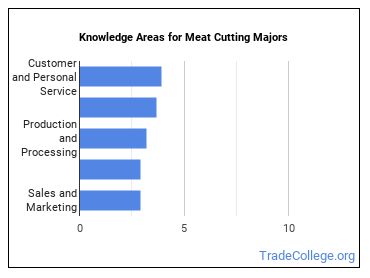
- Customer and Personal Service - Knowledge of principles and processes for providing customer and personal services. This includes customer needs assessment, meeting quality standards for services, and evaluation of customer satisfaction.
- Food Production - Knowledge of techniques and equipment for planting, growing, and harvesting food products (both plant and animal) for consumption, including storage/handling techniques.
- Production and Processing - Knowledge of raw materials, production processes, quality control, costs, and other techniques for maximizing the effective manufacture and distribution of goods.
- English Language - Knowledge of the structure and content of the English language including the meaning and spelling of words, rules of composition, and grammar.
- Sales and Marketing - Knowledge of principles and methods for showing, promoting, and selling products or services. This includes marketing strategy and tactics, product demonstration, sales techniques, and sales control systems.
Skills for Meat Cutting Majors
A major in meat cutting prepares you for careers in which the following skill-sets are crucial:
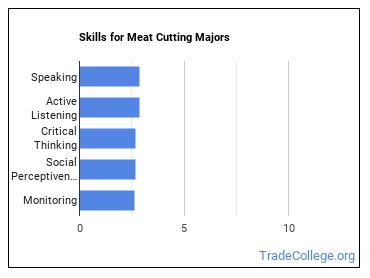
- Speaking - Talking to others to convey information effectively.
- Active Listening - Giving full attention to what other people are saying, taking time to understand the points being made, asking questions as appropriate, and not interrupting at inappropriate times.
- Critical Thinking - Using logic and reasoning to identify the strengths and weaknesses of alternative solutions, conclusions or approaches to problems.
- Social Perceptiveness - Being aware of others’ reactions and understanding why they react as they do.
- Monitoring - Monitoring/Assessing performance of yourself, other individuals, or organizations to make improvements or take corrective action.
Abilities for Meat Cutting Majors
As you progress with your meat cutting degree, there are several abilities you should pick up that will help you in whatever related career you choose. These abilities include:
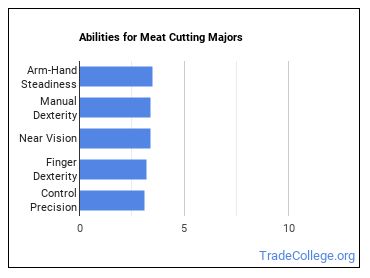
- Arm-Hand Steadiness - The ability to keep your hand and arm steady while moving your arm or while holding your arm and hand in one position.
- Manual Dexterity - The ability to quickly move your hand, your hand together with your arm, or your two hands to grasp, manipulate, or assemble objects.
- Near Vision - The ability to see details at close range (within a few feet of the observer).
- Finger Dexterity - The ability to make precisely coordinated movements of the fingers of one or both hands to grasp, manipulate, or assemble very small objects.
- Control Precision - The ability to quickly and repeatedly adjust the controls of a machine or a vehicle to exact positions.
What Can You Do With a Meat Cutting Major?
Below is a list of occupations associated with meat cutting:
| Job Title | Job Growth Rate | Median Salary |
|---|---|---|
| Butchers and Meat Cutters | 5.7% | $31,580 |
| Slaughterers and Meat Packers | 0.6% | $28,260 |
Who Is Getting an Associate’s Degree in Meat Cutting?
Racial-Ethnic Diversity
At the countrywide level, the racial-ethnic distribution of meat cutting majors is as follows:
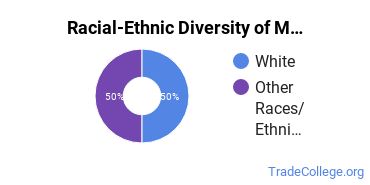
| Race/Ethnicity | Number of Grads |
|---|---|
| Asian | 0 |
| Black or African American | 0 |
| Hispanic or Latino | 0 |
| White | 2 |
| International Students | 0 |
| Other Races/Ethnicities | 0 |
How Much Do Meat Cutting Majors Make?
Salaries According to BLS
Average salaries range from $28,450 to $33,210 (25th to 75th percentile) for careers related to meat cutting. This range includes all degree levels, so you may expect those with a more advanced degree to make more while those with less advanced degrees will typically make less.
To put that into context, according to BLS data from the first quarter of 2020, the typical high school graduate makes between $30,000 and $57,900 a year (25th through 75th percentile). The average person with a bachelor’s degree (any field) makes between $45,600 and $99,000. Advanced degree holders make the most with salaries between $55,600 and $125,400.
Amount of Education Required for Careers Related to Meat Cutting
Some degrees associated with meat cutting may require an advanced degree, while others may not even require a bachelor’s in the field. Whatever the case may be, pursuing more education usually means that more career options will be available to you.
Find out what the typical degree level is for meat cutting careers below.
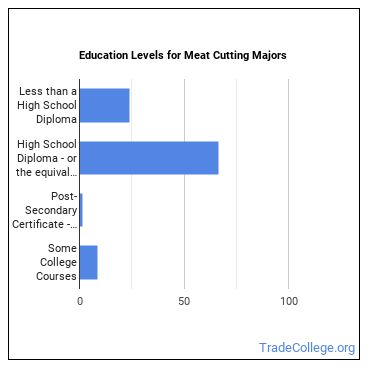
| Education Level | Percentage of Workers |
|---|---|
| Less than a High School Diploma | 23.8% |
| High School Diploma - or the equivalent (for example, GED) | 66.6% |
| Post-Secondary Certificate - awarded for training completed after high school (for example, in agriculture or natural resources, computer services, personal or culinary services, engineering technologies, healthcare, construction trades, mechanic and repair technologies, or precision production) | 1.5% |
| Some College Courses | 8.6% |
Online Meat Cutting Programs
The following table lists the number of programs by degree level, along with how many schools offered online courses in the field.
| Degree Level | Colleges Offering Programs | Colleges Offering Online Classes |
|---|---|---|
| Certificate (Less Than 1 Year) | 0 | 0 |
| Certificate (1-2 years) | 5 | 0 |
| Certificate (2-4 Years) | 0 | 0 |
| Associate’s Degree | 1 | 0 |
| Bachelor’s Degree | 0 | 0 |
| Post-Baccalaureate | 0 | 0 |
| Master’s Degree | 0 | 0 |
| Post-Master’s | 0 | 0 |
| Doctor’s Degree (Research) | 0 | 0 |
| Doctor’s Degree (Professional Practice) | 0 | 0 |
| Doctor’s Degree (Other) | 0 | 0 |
Is a Degree in Meat Cutting Worth It?
The median salary for a meat cutting grad is $28,450 per year. This is based on the weighted average of the most common careers associated with the major.
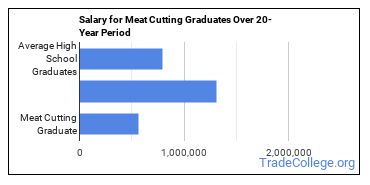
Explore Major by State
Alabama
California
District of Columbia
Idaho
Kansas
Maryland
Mississippi
Nevada
New York
Oklahoma
South Carolina
Utah
West Virginia
Alaska
Colorado
Florida
Illinois
Kentucky
Massachusetts
Missouri
New Hampshire
North Carolina
Oregon
South Dakota
Vermont
Wisconsin
Trades Related to Meat Cutting
You may also be interested in one of the following majors related to meat cutting.
References
*The racial-ethnic minorities count is calculated by taking the total number of students and subtracting white students, international students, and students whose race/ethnicity was unknown. This number is then divided by the total number of students at the school to obtain the racial-ethnic minorities percentage.
- College Factual
- College Scorecard
- National Center for Education Statistics
- O*NET Online
- U.S. Bureau of Labor Statistics
- Usual Weekly Earnings of Wage and Salary Workers First Quarter 2020
- Image Credit: By U.S. Army Europe Images under License
More about our data sources and methodologies.
